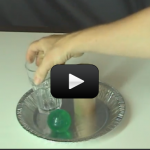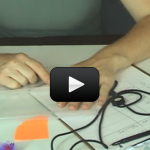Velocity is how fast something is going and in what direction it is going. Direction is what separates the term velocity from speed. If we were talking about a car, we could say that car is traveling with a velocity of 30 miles per hour due East. We will basically just be using the speed aspect of velocity, since for our purposes, the directional aspect confuses things more then necessary.There is another term that is useful here and that is terminal velocity.
The term terminal velocity is normally used when something falling cannot gain any more speed because the air resistance pushing against that something is equal to the force of gravity pulling down on that something. When those two forces are equal (air resistance/friction and gravity) and in opposite directions from each other, the falling object stops accelerating and stays at the same velocity. (We will discuss force and acceleration next lesson.)This is why feathers drop so much more slowly than bowling balls. A feather has a very large amount of air resistance and gravity pulls very lightly on it (the feather is very light).
The term terminal velocity is normally used when something falling cannot gain any more speed because the air resistance pushing against that something is equal to the force of gravity pulling down on that something. When those two forces are equal (air resistance/friction and gravity) and in opposite directions from each other, the falling object stops accelerating and stays at the same velocity. (We will discuss force and acceleration next lesson.)This is why feathers drop so much more slowly than bowling balls. A feather has a very large amount of air resistance and gravity pulls very lightly on it (the feather is very light).
The amount of friction force quickly equals the amount of gravitational force and so the feather accelerates only a small amount, gains little speed and drops nice and easy. The bowling ball has very little air resistance and gravity pulls pretty hard on it (the bowling ball is heavy). A bowling ball can accelerate quite a bit and gain a lot of speed before the force of air resistance pushing up equals the force of gravity pulling down.
The ideas and concepts in physics are based in math. Now before you panic, most of what we're going to do here doesn't require a high level understanding of math. But I do want you to notice how there's a lot of opportunity to learn math right along with the scientific concept you're learning, which is why we have math in the first place. Math helps us make models of physical stuff on paper, so we can better understand and be able to make predictions about what's going to happen in the real world. When scientists launch rockets, they do a lot of math first to make sure they've got enough fuel, can provide safe transport, and make sure that rocket isn't going too fast.
The ideas and concepts in physics are based in math. Now before you panic, most of what we're going to do here doesn't require a high level understanding of math. But I do want you to notice how there's a lot of opportunity to learn math right along with the scientific concept you're learning, which is why we have math in the first place. Math helps us make models of physical stuff on paper, so we can better understand and be able to make predictions about what's going to happen in the real world. When scientists launch rockets, they do a lot of math first to make sure they've got enough fuel, can provide safe transport, and make sure that rocket isn't going too fast.
Scientific Concepts:
- Velocity is the speed and direction of an object.
- Terminal Velocity is when something cannot gain any more speed because the friction pushing against that something is equal to the force of gravity pulling down on that something.
- You can find how far something falls by using the formula d=vt or distance = velocity times time.





